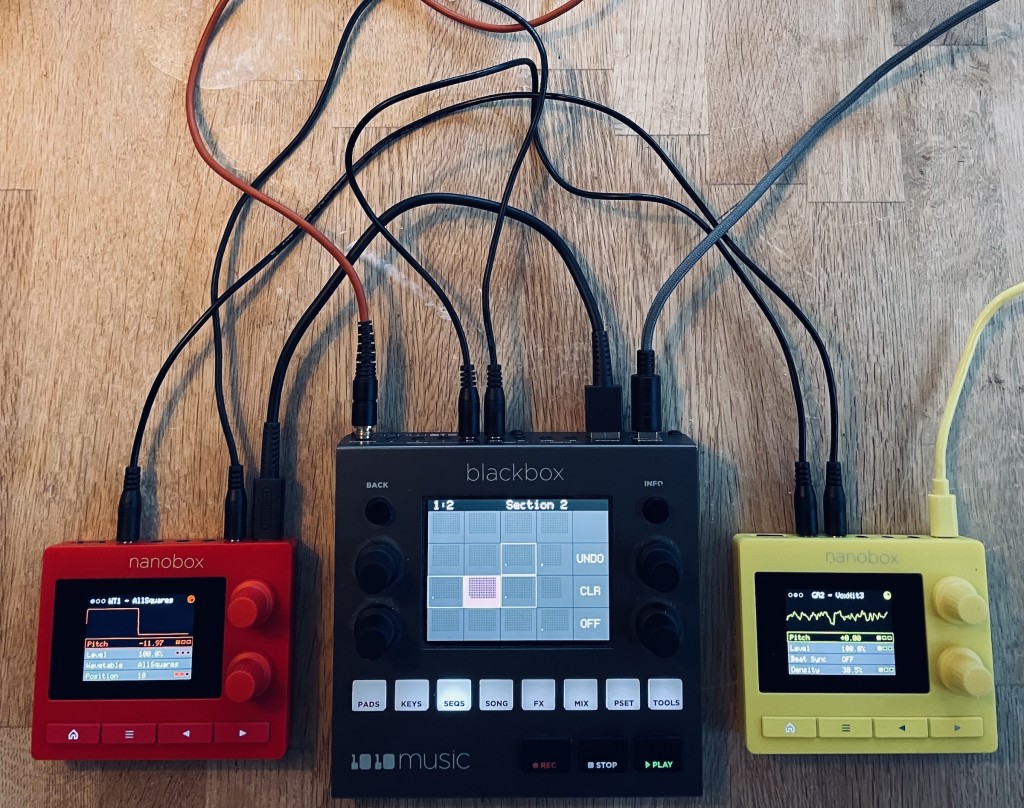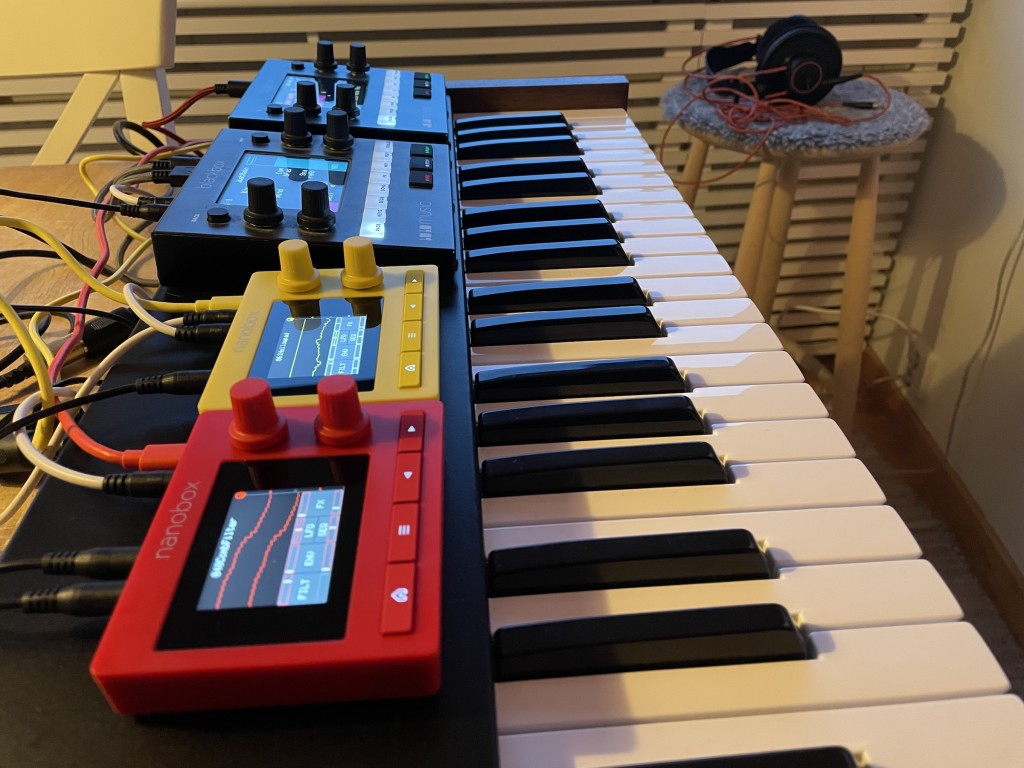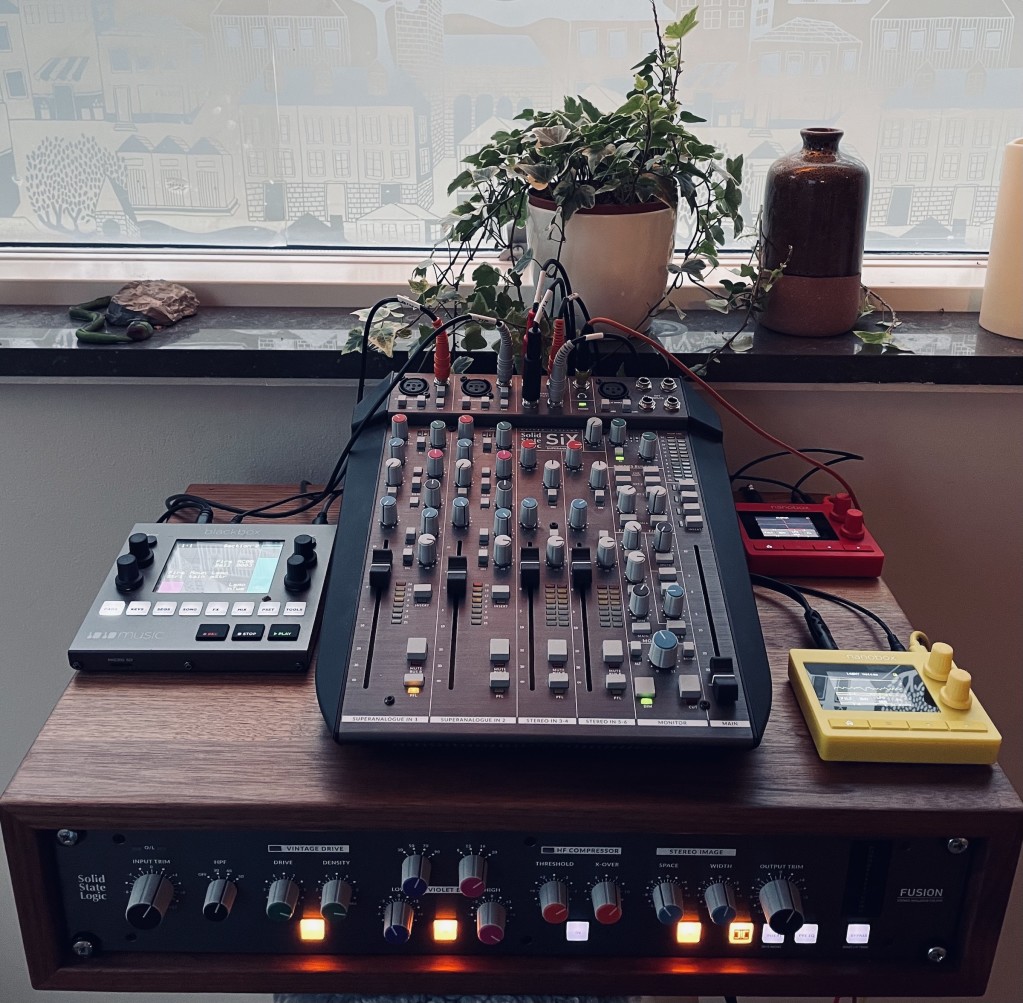It’s the perfect follow-up to 1010’s ultra-compact blackbox sampler and bluebox mixer. Now nanobox adds pint-sized synthesis to the range, with ultra-portable granular and wavetable synths – and we’ve got a first review from resident 1010 expert Andreas Roman.
Okay, first, the news – there’s not one but two synths, each brightly colored and even smaller than its 1010 siblings. These really are small enough to fit in the palm of your hand. US$399 each, available in February direct and from dealers.
Fireball – the wavetable one
- 8-voice polyphony
- 2 wavetables and an oscillator
- 2 filters + 2 envelopes + 2 LFOs + 1 modulation sequencer
Lemondrop – the granular one
- 4-voice polyphony
- 2 granulators and an oscillator
- 2 filters, 2 envelopes, 2 LFOs, 1 modulation sequencer
Both boast a lot of features in common (of course):
- Touchscreen with X/Y morphing controls
- Onboard flanger, distortion, chorus, phaser, delay, and reverb
- Various presets and included WAV files, but also –
- Load your own WAV files (wavetable or granular source, respectively) from microSD
- Power from USB-C – so you can use a USB battery pack
- 2 knobs, 4 buttons
- Mini TRS connections for MIDI in, MIDI out, clock in, line in, line out
- 3.75″ x 3″ x 1.5″ (9.5 x 7.6 x 3.8 cm)
Let’s turn back to our in-house 1010 guru Andreas for the full hands-on test.

Nanotwins
Back in the day, when I was reviewing 1010music’s blackbox sampler, I asked founder Aaron Higgins if this was the first in a new line of products and if a synth was in the works. It just made sense, given that their modular hardware had always been adaptable to new firmware — so could we expect this kind of versatility in a desktop format now? Higgins replied that they were thinking along the same lines but weren’t ready to comment on it yet.
That was the first and last time we spoke about it and this is the first time I mention it to anyone else. Three years down the line (almost), not one but two synths arrive from 1010. While the nanoboxes are their own creations, they share the design vocabulary from 1010’s blackbox and bluebox, despite their substantially smaller size (how’s that even possible?) and new hardware design. They’re twins, similar in some ways, different in others. The Fireball’s a wavetable rascal and the Lemondrop’s a granular dreamer. You’ll fit not one, but both, into the palm of your hand. That has to be a first, right?

Fire and lemon
First, the common denominators. The nanoboxes are polyphonic and mono-timbral. Fireball’s got eight voices and the Lemondrop four. Their main oscillator stack has two sound sources and one classic, digital oscillator, per each voice. For fireball, the sound sources are two wavetables and for the Lemondrop, that’d be two samples with 30 seconds per waveform. The additional oscillator provides you with sine, triangle, square, saw or just some lovely noise, a welcome complement that brings weight to your bass and sizzle to your leads. Really, get your perm on, strap on a keytar and you’ll play power chords like it was 1984.
Next, we got filters. Yep, that’s plural, you get two and the second one can run in parallel or serial with the first one. You can select between a low pass, high pass, bandpass, or notch filter, with cutoff and some extra tweaks on board, such as resonance or frequency range depending on the filter. They retain the same, club-like character we’ve known from the blackbox and bluebox, a clean and precise sculpting tool to bring out character and clean up the mud, though a bit on the harsh side if you’re not careful with your twiddling. I’ve always preferred this approach, using digital filters to enhance what’s already working rather than trying to sound like a Moog. I like that 1010 does with digital what digital does better.
Anyway, after that, you get two four-stage envelopes, assigned to the amplitude and the filter but they’re also sources for modulation, so they can control most of the onboard parameters in one way or another. They’re snappy enough, with a tight decay and sustain to allow for rhythmic creations and smooth as silk in the attack and release for your majestic science fiction pads. Neither filter nor envelopes give you control over the amount applied, apart from the mapping to velocity, but if that concerns you, just lose yourself in modulation. The nanoboxes use all kinds of sources for this, such as velocity, pitch, CC, even aftertouch (!), just recently mentioned envelopes and … yeah, you get it.
There’s a modulation matrix in here and while that’s to be expected in instruments priced substantially higher, I can’t think of a kit this size and price that comes close to this rabbit hole mayhem. Sequential’s retired desktop units, such as the Tetra or the Evolver, come to mind if we’re comparing apples with oranges but still stick to fruit. 1010 even provides us with two LFO’s, where you set the general behavior such as frequency and intensity and then use them as sources to whatever you want to modulate. Most, if not all, parameters can be destinations, and rather than just provide you with a list, let’s just say that what’s in there will keep you busy. If not, you’re just not into modulation, even if you think you are. There’s even an onboard sequencer that can act as a classic pitch playback tool, for arpeggiators or up to 32-step patterns, but also sequence any destination really, including some of the main stack oscillator parameters – wavetable positions or grain sizes, for example.
At the end of the chain, there are two fx slots. One for reverb or delay and one for flanger, phaser, or chorus. The reverb and delay sound great, with enough options to tweak them into experimental territory if that’s your thing or just place your patch where it belongs in the mix. The flanger, chorus, and phaser don’t quite follow the same standard, maybe because they’re a bit more specific and traditionally take place in the foreground and as a consequence, can’t hide what they are. They’re useful, but while I could go for the onboard delay and reverb in a final mix, I’d reach for outboard stuff to get the others to where I want them to be. I found the chorus most useful, creating a decent enough spread when you crank it up.
While we’re on the topic of foreground stuff, I should mention that the sequencer is a bit of a fiddly affair, neither hands-on nor precise, especially if you’re using it to create actual loops. If you just want to play the nanoboxes and not reach for a controller, the grid mode engages more. In my case, it was close to absorbing, as I used the Hold function to build chords and experiment with scales and progressions. Especially with the Lemondrop, if you’re using line input as a source for granular synthesis instead of samples, a held note in the grid mode opens the synth’s gate and applies the Lemondrop’s envelopes and modulation, not to mention the actual pitch of said held note (or pitches, if you’re using chords).
So if you got a nice and dusty string patch going on in the Fireball, you’re still just getting started with your ambient work if you run it through the Lemondrop for additional granular designs. When you’re ready to connect this two-headed beast to external gear, know that the nanoboxes can handle all kinds of incoming midi. There’s a lightning-fast learn feature in there, so it won’t take you long to map out your favorite parameters to your favorite controller. And have at it with your favorite sequencer, at that.

The ins and outs
Still sticking to similarities, the Fireball and Lemondrop also share bodies. You got midi in and out, the latter mostly useful as a thru gate which means you can connect the two and control them both from one midi source (in my case, the pretty darn handsome Extra Deluxe MFG keyboard). There’s clock input and the nanoboxes run on USB-C power, as comfortable with a portable battery as they are with a wall plug. If you’re on the blackbox, it can host one nanobox, giving you a powerhouse of sampling and synthesis that takes up about as much real estate on your desk as a neatly folded magazine. But it’s in the audio department where the real action is, because the nanoboxes send _and_ receive stereo input. Insert any audio source into the Fireball or Lemondrop, apply your preferred amount and you got yourself a nano mixer. There’s even a small compressor on board, though I had to push the input pretty hard to wake it up and even then, I wasn’t sure if it was just placebo or if I actually heard something going on. But the incoming signal also goes through the onboard fx, and it’s worth repeating that in the case of the Lemondrop, it passes through the granular engine if you prefer that before samples. Trust me when I say, at some point, you will. It’s that awesome.
If the blackbox and bluebox are built like metal tanks, the nanoboxes are the plastic equivalent of this. They don’t shine like their older siblings but after some handling, it’s apparent that they’re built to endure the (mis)adventures of gigging, backpacking, studio shuffling and whatever else you might expose them to. The connections are tight and keep the wiring in place, so in the areas where these things matter, the nanoboxes don’t disappoint. The two knobs and four buttons make the blackbox and bluebox seem almost like one switch per function kind of machines, but at least to my surprise, the design language carries over quite well. If you’re familiar with 1010’s tricks and treats especially from the blackbox, you’ll be surfing the nanoboxes like a Tron protagonist in no time. Their practical size means I can fit them comfortably in my palm and work the controls with just one hand. Wisely, 1010 hasn’t cheaped out on screen quality either. I’m getting old and my eyes aren’t what they used to be, but the clear display made me feel like I was 25 again.

Wavetable heart, granular soul
Deceptively similar as they might seem, the Fireball and Lemondrop are two different beasts when it comes to their voice. As mentioned, the Fireball’s a wavetable synth with the expected features present, such as adjusting position, working the pitch, applying modulation to your source sounds but most importantly, importing your own wavetables. Just copy them to the onboard SD card and you’re good. It might sound obvious, but many wavetable synths don’t allow this, or we’ve had to wait for a firmware update until they did. So as simple as the Fireball’s architecture might seem, it’s potentially endless since you got the world’s greatest library and now’s the time to unleash it.
The Lemondrop is … different. It’s a crash course into granular synthesis with parameters and tweaks that’ll make no sense if you’re new to this. But that’s part of the risk and reward when you head into the unknown, because the places you’ll find with the Lemondrop, they’re from another world. If the Fireball sounds like you expect it to, the Lemondrop sings in another choir. Hell, it’s a choir all by itself. I enjoyed the qualities of the Fireball but the Lemondrop just sucked me in. That inherently haunting sound of melancholia, a processing form that’s shaped my own productions for some time, that sound is clear and present here. But with two sample sources in a polyphonic architecture, there’s no doubt the Lemondrop’s harder to fit into your rig, because what do you do with this strange-sounding creature?
The onboard patches sell it short since they sound like mostly any digital synth and why would you want that when you can just get the more comprehensible Fireball? But start with a simple grain or two from a string or a chord, maybe from your own library or use the live input, slow down the playback ratio, widen the window, introduce some jitter, modulate the pitch ever so slightly, push it through a bandpass filter with a tint of high pass, send it through the reverb with a long tail and muddy diffusion. And then, play it. As in, sit down and play it. You’ll have to search far and wide to find another synth that sounds like the Lemondrop.

Conclusion
The nanoboxes are tiny. But they don’t sound tiny. At all. They compare favorably to instruments priced higher and in some aspects, they outperform these equivalents. These aren’t boxes that sound good, considering the price. These are boxes that sound good, period. Fully fleshed top voiced kits in a price range where it’s not uncommon that output quality takes a hit. Well, maybe, but not on 1010’s shift.
However, instruments of this size and not priced like a Prophet 5, obviously do some things that you might not like. I wouldn’t say that working with the nanoboxes is fun exactly, in the way that operating a one knob per feature synth can be or being in the zone with an Elektron. They’re convenient and functional, made to get the job done, but you won’t get into some kind of funky Pioneer groove. This is a designer’s tool.
Also, be aware that 1010’s focused approach on synth design might not fit your idea of what needs to go into an instrument to make it worthwhile. These are boxes without portamentos and filter envelope amounts, they’re not multi-timbral and the onboard sequencer is a curiosity to operate. There are parameters you can’t modulate, perhaps you feel that anything that reads samples should stream and maybe even loop these days. And you know, maybe they’re just too goddam small.
But at some point, reason must align with position and I would argue that the blessing of digital is also its curse. There’s so much stuff you can do with wavetables and granular engines, it’s easy for a dev to get tempted into cramming so much into a box, they forget about coherence. I guess I’ll take some heat for saying this, but as beautiful as WaveState and Iridium are, they’re an undecided mess like many (but not all) followers of the WaveStation legacy have been since the ’90s. The Fireball and Lemondrop are not a mess. They are clear and precise. They sound fantastic. Together, they become the Castor and Pollux of sound design, a creature of mythological proportions. I’ll say it again – the Fireball through the Lemondrop is just pure awesome. To that end, it’s almost an act of kindness to provide this level of quality within a price range that most musicians on a budget can afford. The nanoboxes are a true testament to the fact that you don’t need many tools, but just the right ones, to get stuff done. And write lovely music. Thank you, 1010.
And some music
In the tradition of Andreas’ ongoing review series, we get to yet again enjoy some of his absolutely enchanting music – here Fireball + Lemondrop + black-box for a full 1010music production. Absolutely moving: